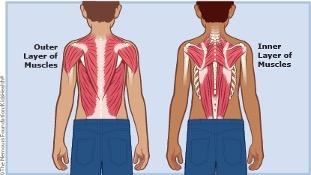Back Strain
Back Strain: How to Care for Your Child
Back strain can be due to an injury or from putting too much stress on the back. It usually gets better within a few weeks.

Your Child's Diagnosis
Muscles tighten and relax like rubber bands to help the body move. A strain happens when a muscle is stretched too far. Kids may strain the back when playing sports, running, lifting, falling, or carrying a backpack that's too heavy. A kid with back strain often has dull pain that started suddenly. Sometimes the pain is sharp, aching, or burning. It can happen anywhere in the back.
Back strain is common in children, especially young adolescents. It is usually not a sign of something serious and often goes away on its own. Your health care provider examined your child to check that the bones seemed normal and that the muscles and nerves were working properly. You can now take steps at home to help your child feel better.
Home Care Instructions
- Your child should continue participating in normal activities as long as they do not cause pain. Stretching exercises or low-impact exercises like walking, swimming, and bicycling are often good choices.
- If your child is uncomfortable, you may give acetaminophen OR ibuprofen, if recommended by your health care provider. These medicines can mask pain, so your child should avoid strenuous activity while taking them.
- Massage may help your child feel better.
- If your child's back pain is from an injury:
- For 2–3 days after the injury, apply a cold pack to the area for 15 minutes every 2–3 hours when your child is awake. Keep a towel between the ice and skin.
- Do NOT apply heat in any form to the injured area for at least 24 hours, or until any swelling is gone (whichever is later). Heat might increase swelling and pain.
Special Instructions
- Schedule any follow-up appointments as directed.
- Your health care provider may suggest stretching or strengthening exercises.
- If the pain continues, your health care provider may refer your child to a physical therapist.
- Reduce stress on the back through smart backpack choices. Choose a backpack with two wide shoulder straps and a padded back. Your child should not carry more than 10% to 15% of his or her body weight in the pack.
Call Your Healthcare Provider if...
The injured area:
- Has increased pain or swelling.
- Doesn't start to feel better in 5–7 days.
- Has signs of infection, such as fever, warmth, redness, or streaks of red.
Your child:
- Still has pain after 2 weeks.
- Has urine (pee) or stool (poop) accidents.
- Has pain that interrupts sleep.
- Has pain that travels down the leg.
- Cannot do regular activities.
Go to the ER if...
Your child:
- Has leg weakness or trouble walking.
- Develops numbness in the arms or legs.
Other Things to Think About
Your child can help to prevent future injuries by warming up and gently stretching before exercising, and stopping exercise when the muscles are tired.